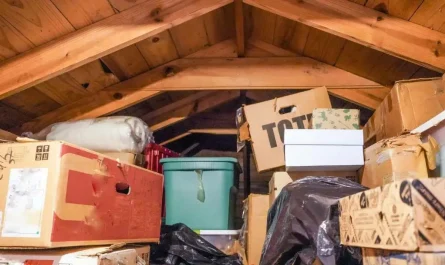Mold on Wood? 7 Easy Solutions You Can Do Yourself
You can relate to the depressing sensation that arises when you see those black, fuzzy patches appear on your flooring or wooden furniture. I’ve also wondered whether the wood is damaged, whether my family’s health is in jeopardy, or whether I’ll have to replace a piece of furniture entirely. In addition to being unsightly, mold can cause allergies, respiratory issues, and even damage wood if left unchecked for an extended period of time.
The good news is that, with the correct technique, removing mold from wood isn’t as difficult as it may seem. The issue is that the majority of advice either skips over crucial safety precautions that protect your home (and your lungs) or dives right into bleach-heavy remedies. What you really need is a methodical, safe, and transparent approach to mold removal that doesn’t result in further harm.
I’ll lead you through seven tried-and-true techniques in this article.Simple natural therapies and more potent medicines have been used in actual houses. Since no one wants to fight the same battle twice, you’ll learn not only how to eradicate mold but also how to prevent it from returning.
Tell me, have you attempted to deal with mold on your own before, or are you searching for solutions for the first time?
Safety First Preparing Before You Remove Mold
Let’s be clear before you reach for a sponge or spray bottle: cleaning up mold can expose you to microscopic airborne spores that you most definitely do not want in your lungs. I usually start with the appropriate protective gear because of this.
Before you start, I advise you to keep the following in mind:
-
Gloves
To keep mold and cleaning chemicals off your skin. -
Mask or respirator
A simple N95 or KN95 goes a long way to block spores. -
Goggles
Mold irritates the eyes, so don t skip these.
Ventilation is also important. To force polluted air outside, open adjacent windows and, if you can, turn on an outward-pointing fan. When the workspace doesn’t become stuffy while you’re working, you’ll notice a change, I promise.
I’ve also discovered that knowing when to stop can often be the best safety precaution. It is usually safer and wiser to hire professionals if the mold has spread over a large area of wood (say more than 10 square feet). According to the CDC’s mold cleanup guidelines, homes typically lack the specialized equipment needed for large-scale mold eradication.
Early plumbing leak repair is another important safety precaution that many people forget. The ideal environment for mold growth can be created by even a tiny leak. For this reason, before you start dealing with mold, I always advise knowing the eight plumbing leak repairs that every homeowner should be aware of in 2025.
The 7 Proven Methods to Remove Mold From Wood (Step-by-Step)
Let’s begin the real cleaning now that you are secure and ready. I’ve observed seven techniques that regularly work throughout the years. While some are heavy-duty for tenacious infestations, others are mild enough for a fast wipe-down.
1. Soap and Water Best for Light Mold
Start easy if the mold patch is little and hasn’t sunk deeply.
How to accomplish it:
- Mix mild dish soap with warm water.
- Dip a soft cloth or sponge and scrub gently.
- Wipe dry immediately to prevent more moisture.
Since it is non-toxic and protects the wood, I apply it on fresh or surface-level areas.
2. Vinegar Solution Eco-Friendly and Effective
Since vinegar naturally destroys mold without emitting harsh smells, it’s one of my go-to cures.
Actions to take:
- Pour white vinegar into a spray bottle (undiluted works best).
- Spray directly on the moldy area.
- Leave it for about an hour, then wipe with a clean cloth.
Although it may have a strong smell for a long, children and dogs can safely use it.
3. Baking Soda Spray Deodorize + Kill Mold
Baking soda can be used to eliminate the musty odor left by mold.
How to apply:
- Mix 1 teaspoon baking soda with 2 cups of water.
- Shake well and spray onto the wood.
- Scrub gently, then dry the surface.
This not only eliminates moderate mold but also eliminates smells that vinegar by itself can’t usually resolve.
4. Hydrogen Peroxide Deep Cleaning Power
Hydrogen peroxide works better than vinegar if the mold has begun to penetrate the wood grain.
Actions to take:
- Use a 3% hydrogen peroxide solution.
- Spray it directly and let it sit for 10 15 minutes.
- Scrub lightly and wipe clean.
Additionally, it lightens mold stains, giving the wood a more recent appearance.
5. Borax Solution Long-Term Prevention
Borax differs from bleach in that it prevents mold growth in addition to killing it.
Application & recipe:
- Mix 1 cup of borax with 1 gallon of water.
- Apply the solution with a sponge or cloth.
- Don t rinse it off leaving a thin layer behind helps prevent regrowth.
For locations that have a tendency to remain damp, I always suggest this.
6. Sanding For Stubborn Mold Spots
Sometimes mold penetrates too deeply to be cured by spraying. Sanding is effective at that point.
How to do it securely:
- Wear a proper mask (dust + mold spores = bad combo).
- Use fine-grit sandpaper and lightly sand only the affected area.
- Clean dust with a vacuum fitted with a HEPA filter.
Since it destroys the wood’s surface, this should only be used as a last resort to get rid of imbedded mold.
7. Commercial Mold Cleaners When You Need Heavy Duty Help
Commercial products made specifically for wood are available if do-it-yourself approaches aren’t sufficient.
Advantages:
- Stronger, faster results.
- Some eco-friendly formulas available now.
Cons:
- More expensive.
- Some contain harsh chemicals, so check labels carefully.
I only use these when natural remedies don’t work or when the mold has already covered a lot of ground.
Eco-Friendly vs Chemical Solutions Which One Should You Choose?
My initial thinking whenever I deal with mold is: can I get away with using natural solutions, or do I require chemicals? The severity of the mold and what you feel comfortable putting within your house will determine the response.
Natural cures (baking soda, borax, and vinegar):
-
Pros:
- Non-toxic and safe around kids and pets
- Affordable and easy to find
- Gentle on wood surfaces
-
Cons:
- May take multiple applications
- Not as effective for deeply embedded mold
- Non-toxic and safe around kids and pets
- Affordable and easy to find
- Gentle on wood surfaces
- May take multiple applications
- Not as effective for deeply embedded mold
Chemical solutions (commercial cleansers, hydrogen peroxide):
-
Pros:
- Kill mold faster and more thoroughly
- Useful for larger infestations
-
Cons:
- Can release fumes if not ventilated properly
- Some may damage finishes or stain wood
- Kill mold faster and more thoroughly
- Useful for larger infestations
- Can release fumes if not ventilated properly
- Some may damage finishes or stain wood
When feasible, I personally begin using natural ways, but if mold continues to recur, I won’t think twice about switching to stronger cleaners. The EPA’s mold removal guidelines state that tiny areas can be cleaned by hand, while more difficult situations may require the use of chemicals or experts.
It all boils down to cost, effectiveness, and safety. Consider your home; if you have children or pets, going eco-friendly can be the wisest course of action.
Preventing Mold from Coming Back
Making sure the mold doesn’t come back is the true victory; getting rid of it is only half the battle. Mold will return sooner than you think if you don’t address the underlying problem, as I discovered the hard way.
This is what works:
-
Keep wood dry:
Use dehumidifiers in damp rooms, open windows, and let in sunlight when possible. Mold thrives in dark, moist spaces. -
Protective coatings:
A good wood sealant creates a barrier against moisture. This is especially useful for furniture near windows or bathrooms. -
Regular inspection:
Check corners, under rugs, and behind furniture every few months. Catching small spots early saves you a major headache later.
Particularly challenging are kitchens, which conceal more mold and germs than you might think. Check out these nine secret germ havens in your kitchen and learn how to quickly clean them if you haven’t previously.
Wet objects should be dried within 24 to 48 hours, according to the CDC’s mold prevention guidelines. You can significantly reduce the likelihood of mold formation if you can develop that habit.
Common Mistakes People Make (and How to Avoid Them)
I’ve seen folks repeatedly make the same mistakes when it comes to mold cleanup, and it usually makes the issue worse.
1. Using bleach on porous wood:Bleach might look like it s working, but it only kills mold on the surface. The roots inside the wood survive, meaning it will come back quickly.
2. Ignoring concealed mold: Mold is not necessarily absent just because it is invisible. Mold often hides behind furniture, under carpets, or inside wall cavities. A musty smell is usually your first clue.
3. Over-wetting the wood:Too much water while cleaning makes things worse. Mold loves moisture, and soaking the wood can actually feed it instead of killing it. Always wipe dry right after cleaning.
A lot of these mistakes actually come from habits at home like ignoring leaks or storing things the wrong way. If you want to dive deeper, check out our guide on10 common mistakes that invite mold into your home and how to avoid them.
If you avoid these mistakes, you ll save yourself time, money, and the frustration of fighting the same battle twice.
When to Call a Professional
Sometimes you have to be honest with yourself DIY isn t always enough. I ve learned that mold can dig deeper into wood than it looks on the surface.
Here are the signs you shouldn t ignore:
-
Mold covers
more than 10 square feet
. - The wood feels soft, warped, or crumbles when touched.
- You ve tried cleaning before and the mold keeps coming back.
- Strong musty odor remains even after cleaning.
When that happens, DIY solutions can end up costing you more in the long run. A professional will not only remove the visible mold but also identify moisture problems causing it.
What to look for in a pro:
-
Certification from the
IICRC (Institute of Inspection Cleaning and Restoration Certification)
. -
Experience with
wood surfaces specifically
(not just drywall or carpet). - Clear estimate of both cost and scope before starting.
Yes, hiring an expert costs more upfront, but it reduces the risk of health issues and expensive repairs later. Think of it as an investment in your home s safety.
The 7 Safe Methods at a Glance
If you re skimming or just need a refresher, here are the seven methods again in quick form:
- Soap and water gentle for light mold.
- Vinegar natural and eco-friendly.
- Baking soda removes mold + odor.
- Hydrogen peroxide deeper clean, lightens stains.
- Borax kills and prevents regrowth.
- Sanding for stubborn embedded mold.
- Commercial cleaners heavy-duty option when DIY fails.
This list makes it easy to match the method with your situation without scrolling back and forth.
Final Thoughts
Dealing with mold on wood can feel overwhelming at first but you ve seen now that you have options. With the right prep and the right method, you can handle most mold safely without damaging your home.
Remember, the real key isn t just cleaning it sprevention. Keep the wood dry, watch for early signs, and don t be afraid to step back and call a pro if it s beyond your reach.
At the end of the day, this is about taking back control of your space before mold takes it from you.
I d love to hear from you have you ever tried removing mold from wood yourself? Which method worked best for you?
Want more DIY fixes and smart home care ideas? VisitBuild Like Newfor expert-backed solutions you can trust.
Disclaimer: This article is for informational purposes only and does not replace professional advice. If mold growth is extensive or causing health issues, consult a certified professional for safe removal.
Table of Contents
-
Safety First Preparing Before You Remove Mold
-
The 7 Proven Methods to Remove Mold From Wood (Step-by-Step)
-
1. Soap and Water Best for Light Mold
-
2. Vinegar Solution Eco-Friendly and Effective
-
3. Baking Soda Spray Deodorize + Kill Mold
-
4. Hydrogen Peroxide Deep Cleaning Power
-
5. Borax Solution Long-Term Prevention
-
6. Sanding For Stubborn Mold Spots
-
7. Commercial Mold Cleaners When You Need Heavy Duty Help
-
-
Eco-Friendly vs Chemical Solutions Which One Should You Choose?
-
Preventing Mold from Coming Back
-
Common Mistakes People Make (and How to Avoid Them)
-
When to Call a Professional
-
The 7 Safe Methods at a Glance
-
Final Thoughts
-
1. Soap and Water Best for Light Mold
-
2. Vinegar Solution Eco-Friendly and Effective
-
3. Baking Soda Spray Deodorize + Kill Mold
-
4. Hydrogen Peroxide Deep Cleaning Power
-
5. Borax Solution Long-Term Prevention
-
6. Sanding For Stubborn Mold Spots
-
7. Commercial Mold Cleaners When You Need Heavy Duty Help




